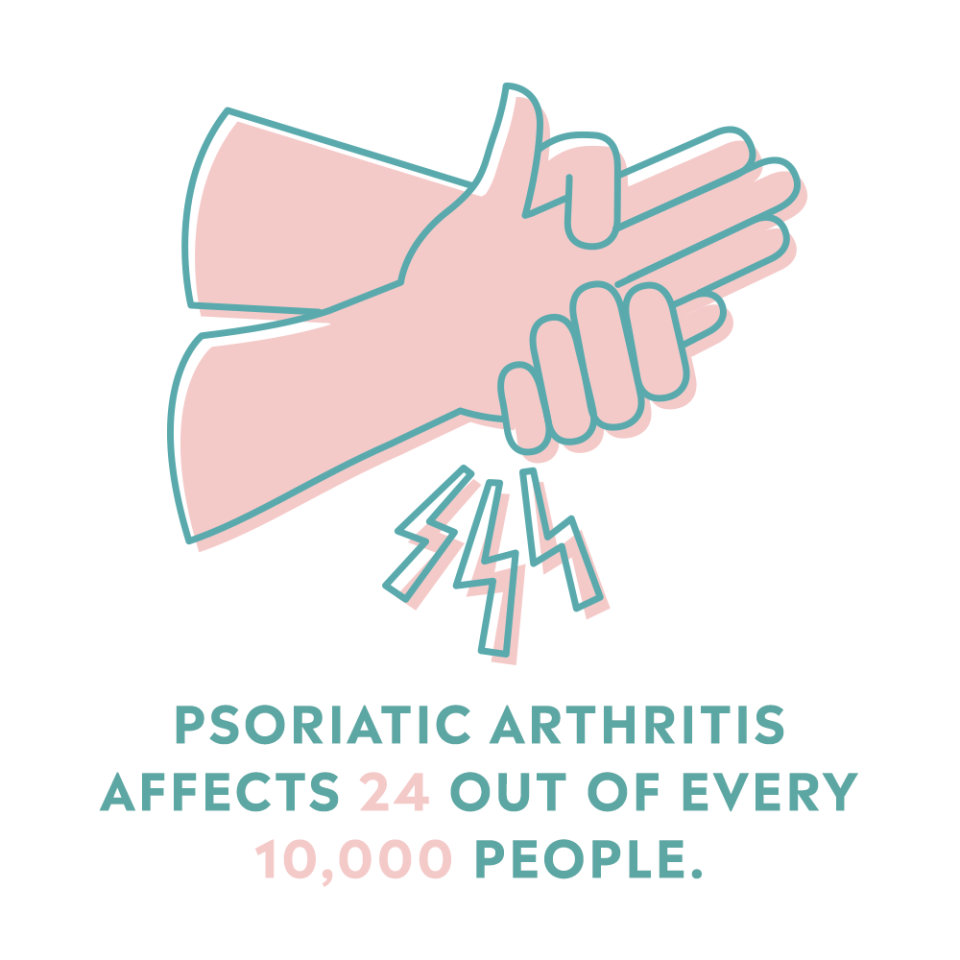Everything You Need to Know About Psoriatic Arthritis

When you hear the word “psoriasis,” you might think of itchy, scaly patches of skin. “Arthritis” conjures up images of painful, swollen joints. But you can have both at the same time; it’s called psoriatic arthritis, or PsA.
What is psoriatic arthritis?
This type of inflammatory arthritis occurs when someone’s autoimmune system starts to attack their own body, explains Rebecca Haberman, M.D., a rheumatologist at NYU Langone Health. [1] This causes painful, stiff joints that often swell, in addition to the plaques and scales caused by psoriasis.

Psoriatic arthritis affects 24 out of every 10,000 people. [2] It most often develops in people in their 30s to 50s, though it can begin at younger ages and even occur in children. [3] If caught early, men and women—who are equally at risk of the condition—can take steps to manage their psoriatic arthritis and prevent joint damage.
What are the types of psoriatic arthritis?
There are five main subtypes of psoriatic arthritis. “These are not mutually exclusive,” Dr. Haberman explains, meaning someone can have more than one subtype at once, which can make it difficult to diagnose, she adds.
Asymmetric oligoarticular: The most common type of psoriatic arthritis, [4] this is when the condition affects different joints on opposite sides of the body. [2]
Symmetric polyarthritis: The second-most common psoriatic arthritis subtype, [4] this is when the same joints on both sides of the body are affected. [2]
Spondylitis: Lots of pain and stiffness in the back may indicate this type of psoriatic arthritis. Inflammation occurs in the joints between the spine's vertebrae. [2]
Distal interphalangeal predominant: The joints in the fingers and toes closest to the nails are called the distal interphalangeal joints. Hence, this type of psoriatic arthritis affects those joints and sometimes the nails. [2]
Arthritis mutilans: While rare, [4] arthritis mutilans is the most severe type of psoriatic arthritis. It leads to deformations in joints in the hands and feet on one or both sides of the body.
What are the causes and risk factors of psoriatic arthritis?
It’s still unclear what causes psoriatic arthritis, but it appears that both “nature” and “nurture” play a role. [5] There is a genetic predisposition, but infections or trauma—such as a strep infection, stubbed toe, or cut—can set it off, Dr. Haberman says. “We don't know the pathophysiology behind this, but it may be that it triggers an inflammatory cascade that cannot be stopped,” she says.
Known risk factors for the condition include:
Psoriasis: Although you don’t need to have this skin condition to develop psoriatic arthritis, having it will put you at the greatest risk. [6]
Genetics: Two out of every five people living with psoriatic arthritis have at least one close family member who’s been diagnosed with either psoriatic arthritis or psoriasis. [2]
Age: Although the onset of psoriatic arthritis most commonly occurs in people’s 30s to 50s, it can develop at any age. [2] “This is because your immune system can go out of whack at any time, versus arthritis which is caused by a lot of activity and overuse. This typically happens later in life,” Dr. Haberman explains.
What are the symptoms of psoriatic arthritis?
Along with the red, itchy patches that come along with psoriasis, those with PsA will have additional symptoms that may come and go. They can occur in just one type or several types of joints, and on one or both sides of the body. [6] Symptoms include:
[5][6]
If you experience any of these symptoms and suspect it may be psoriatic arthritis, the sooner you can see a doctor, the better. “We know that a delay in diagnosis of as little as six months can lead to much worse outcomes,” Dr. Haberman says. “It’s very hard to reverse damage to the joints. It’s much easier to treat psoriatic arthritis when it’s in the [early] inflammation stage.”
How is psoriatic arthritis diagnosed?
If you have access to one, it’s best to see a rheumatologist if you think you may have psoriatic arthritis. “Because there are so many different presentations of psoriatic arthritis, someone who is not specialized to treat the condition may miss it,” Dr. Haberman says.
The doctor will first ask about your medical history and family history. They’ll want to know when you developed psoriasis (if you have it) and what symptoms you’re experiencing. They will also do a physical exam to check your skin, joints, muscles, and tendons.
While there is no one test that can confirm psoriatic arthritis, some tests that can support the diagnosis include:
Blood work to look for markers of inflammation [7] and proteins called rheumatoid factors. [8] Your immune system produces rheumatoid factors, which can attack healthy tissue, causing inflammation. [9]
X-rays to look for damage to the joints. [8]
Joint fluid samples to rule out other conditions. [8] The doctor inserts a needle into an affected joint and removes fluid to analyze.
None of these tests pose significant risks. With the joint test, since the doctor is sticking a needle through the skin into a joint, there's a “very, very small chance of infection, but we [doctors] do this all the time, so the risks are very low,” Dr. Haberman says.
Psoriatic arthritis treatment
On top of taking medication to treat any skin plaques, you will likely take medications to treat joint pain. Treatment for psoriatic arthritis calls for shared decision-making, Dr. Haberman says. With your doctor, you will discuss the severity of your condition, which body parts are affected, any other health conditions you have, and your medication preferences (an oral prescription vs. an injection, for example), she explains. The following are the most common medications for psoriatic arthritis:
Non-steroidal anti-inflammatory drugs (NSAIDs): For very mild cases, over-the-counter medications such as ibuprofen (Motrin or Advil) or naproxen (Aleve) may be all that's necessary. In addition to relieving pain, these fight inflammation. [8]
Disease-modifying antirheumatic drugs (DMARDs): These drugs also fight inflammation[10] but are stronger than NSAIDs. One of the most common DMARDs is methotrexate (Trexall, Otrexup, Rheumatrex). Others include leflunomide (Arava), sulfasalazine (Azulfidine), and cyclosporine (Neoral, Sandimmune, Gengraf). [7]
Biologics: For more severe cases, biologics target specific cytokines (proteins released by the immune system to spur other immune cells into action to fight pathogens) in the inflammatory pathway, Dr. Haberman explains. In addition to reducing inflammation, some of these also help with skin psoriasis. [7]
Steroids: “If someone is in a ton of pain, they can’t move, and their joints are totally inflamed, we may consider steroids,” Dr. Haberman says. “But we don’t use them chronically because they have a lot of side effects, including things like increased blood sugar, high blood pressure, weight gain, and loss of bone strength.”
Joint replacement surgery: “If someone has enough joint damage that no amount of medication can make that better,” surgery may be necessary, Dr. Habeman says. Surgeons implant artificial joints made of metal and plastic. [8]
Complications of psoriatic arthritis
Joint damage is the main complication of psoriatic arthritis, but the condition has several comorbidities. Be mindful of the following:
[6] [7] [11]
How to prevent psoriatic arthritis flare-ups
At this time, there’s no way to prevent psoriatic arthritis. As researchers begin to look into ways to prevent the condition, you can take action to help prevent flare-ups or sudden worsening of your symptoms.
Take your medication as directed. “When they feel better, sometimes people will take less medication or stop taking it,” Dr. Haberman says. “But a lot of times this causes them to develop flares again.” If you wish to come off of or change your medication, talk to your provider first. “A slow taper is often better than stopping completely,” Dr. Haberman says.
Maintain a healthy weight. “People who are obese are more likely to develop psoriatic arthritis and less likely to respond to treatment,” Dr. Haberman says. It may be that, since medications don’t come in different doses, these people don’t get as much medication. Or it may be that, because adipose (fat) tissue is inflammatory, the medications have to overcome inflammation from psoriatic arthritis and obesity, Dr. Haberman explains. A healthy weight also reduces stress on the joints and can lead to less pain. [8]
Be active. Doing so will help keep your joints flexible and the surrounding supporting muscles strong. Consider walking, swimming, biking, or yoga, which are gentle on the joints. [7,8]
Sources
[1]https://nyulangone.org/doctors/1841600335/rebecca-haberman
[2]https://medlineplus.gov/genetics/condition/psoriatic-arthritis/
[3] https://www.rheumatology.org/I-Am-A/Patient-Caregiver/Diseases-Conditions/Psoriatic-Arthritis
[4] https://www.clevelandclinicmeded.com/medicalpubs/diseasemanagement/rheumatology/psoriatic-arthritis/
[5] https://www.niams.nih.gov/health-topics/psoriatic-arthritis
[6] https://www.mayoclinic.org/diseases-conditions/psoriatic-arthritis/symptoms-causes/syc-20354076
[7] https://www.rheumatology.org/I-Am-A/Patient-Caregiver/Diseases-Conditions/Psoriatic-Arthritis
[8] https://www.mayoclinic.org/diseases-conditions/psoriatic-arthritis/diagnosis-treatment/drc-20354081
[9] https://www.mayoclinic.org/tests-procedures/rheumatoid-factor/about/pac-20384800
[10] https://www.ncbi.nlm.nih.gov/books/NBK507863/
[11] https://pubmed.ncbi.nlm.nih.gov/27530409/
You Might Also Like

